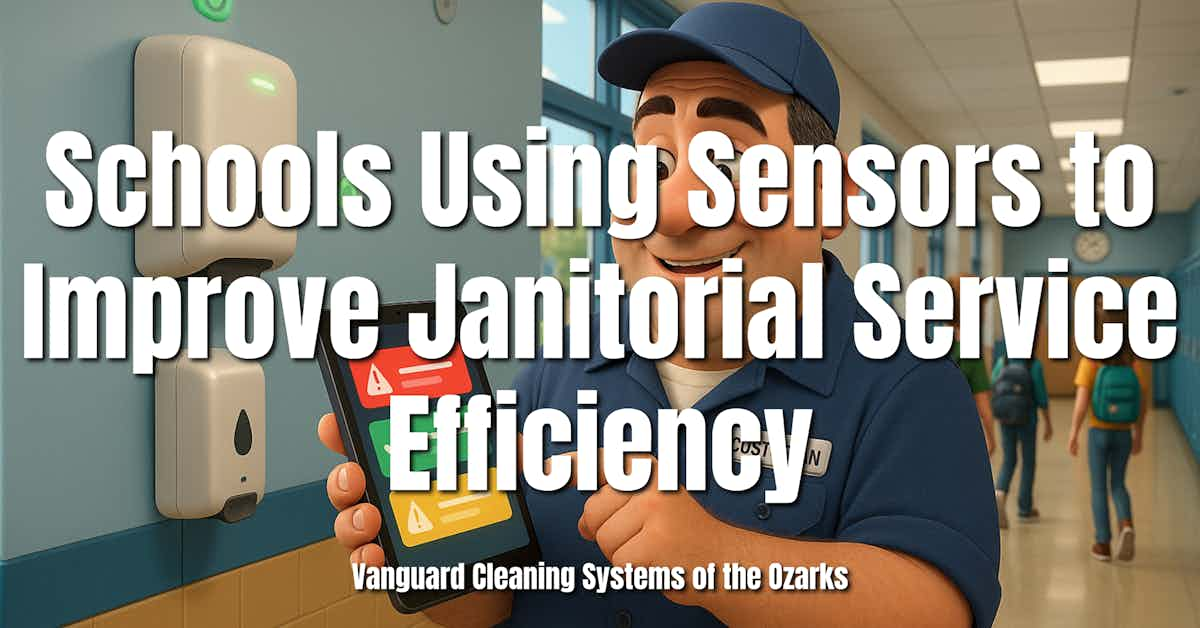Smart sensors are transforming school cleaning from routine schedules to data-driven efficiency that protects health and saves resources.

Why Clean Schools Need Smarter Janitorial Efficiency
Clean schools are not just about appearance—they are central to student health, safety, and academic performance. Respiratory illnesses, gastrointestinal infections, and allergy flare-ups are all linked to poor sanitation, costing districts in both attendance and achievement. Despite the critical role of custodial services, efficiency in school cleaning has historically been inconsistent. Early research emphasized the need for training and structured sanitation standards, yet many schools operated without evaluation systems, leaving performance uneven.
Today, custodians also face significant ergonomic strain. Studies of janitorial tasks show repetitive stress on the shoulders, back, and hands from daily rounds—often repeated in spaces with little or no occupancy. Static cleaning schedules lead to inefficiency, wasted labor, and uneven sanitation.
Sensor technology provides a new opportunity. By delivering real-time data on occupancy, air quality, and supply levels, schools can shift from rigid routines to demand-based cleaning. This approach reduces wasted labor, minimizes shortages, prevents costly repairs, and supports staff well-being. The opportunity is clear: data-driven cleaning can transform custodial operations into measurable, proactive, and health-focused systems.
The Historical Context of School Janitorial Services
The importance of janitorial work in schools has been recognized for over a century. Early research in the 1910s highlighted the role custodians played in protecting student health through proper sanitation. Yet custodial performance often depended on personal initiative rather than structured training.
By the 1940s, administrators noted the absence of standardized hiring, training, and evaluation protocols for custodians. Without performance metrics, schools relied on reactive cleaning—responding to complaints rather than preventing problems.
Key lessons from history:
- Efficiency improves when custodial services are measured, trained, and evaluated.
- Structured systems—not assumptions—are the foundation for consistent performance.
These lessons remain relevant today. Just as early researchers called for structured training, modern schools can use technology to provide the measurement and accountability that was previously missing.
The Modern Challenge of Janitorial Work
Custodial work in schools is physically demanding. Ergonomic research documents significant strain during routine tasks such as mopping, bending, and carrying supplies. Over time, these repetitive movements lead to injury and reduced job longevity.
The inefficiency of static cleaning schedules compounds the problem. Many schools still operate on fixed rotations, cleaning classrooms and restrooms regardless of whether they were used. Custodians may spend time disinfecting an unused classroom while restrooms serving hundreds of students go unattended. This mismatch between effort and need creates inefficiency, staff fatigue, and frustration among students and teachers.
Action items for schools:
- Align labor with real usage, not rigid timetables.
- Protect worker health by reducing unnecessary rounds.
- Introduce measurable benchmarks for cleaning outcomes.
Emerging Practices in Operational Efficiency
Even without sensors, schools have improved custodial efficiency through structured accountability. For example, waste segregation programs demonstrate how custodians adapt effectively when given measurable goals. Sustainability initiatives that tie cleaning to recycling and energy targets show how custodial services can align with broader institutional objectives.
These programs highlight three principles:
- Staff perform more consistently when guided by structured systems.
- Linking custodial work to institutional goals strengthens impact.
- Monitoring and reporting drive long-term accountability.
These lessons naturally extend to sensor systems. Just as recycling programs track metrics like diversion rates, sensors can measure occupancy, supply levels, and air quality to guide custodial performance.
The Role of Sensors in Shaping Future Efficiency
Sensors allow schools to transform janitorial operations into data-driven systems. Instead of relying on static schedules, custodians can act on real-time information about how spaces and supplies are used.
Key applications in schools:
- Occupancy Sensors: Measure traffic in restrooms, gyms, and classrooms, signaling when cleaning is needed.
- Smart Dispensers: Track paper, soap, and tissue levels, sending alerts before supplies run out.
- Air Quality Sensors: Monitor CO₂, humidity, and pollutants to trigger cleaning or ventilation checks.
- Leak and Moisture Sensors: Detect plumbing issues early, preventing costly damage and downtime.
Benefits for schools:
- Labor efficiency by eliminating unnecessary rounds.
- Reduced ergonomic strain through smarter task allocation.
- Fewer consumable shortages and less waste.
- Higher satisfaction among students and staff.
- Transparent accountability through measurable performance data.
Barriers and Considerations for Schools
Privacy and Security
Sensors must be configured to protect privacy, measuring usage without tracking identity. Cybersecurity is equally critical, requiring secure networks and vetted vendors.
Action items:
- Use anonymous occupancy counts.
- Vet vendors for cybersecurity certifications.
- Segment sensor data networks from academic systems.
Budget and Procurement
Upfront costs can be significant. Long-term savings depend on careful planning.
Action items:
- Start with pilot programs in high-traffic zones.
- Compare vendor contracts for hidden costs.
- Build ROI projections on labor, consumables, and maintenance savings.
Training and Staff Readiness
Data is only useful if staff know how to act on it. Training and redesigned schedules are essential.
Action items:
- Provide mobile dashboards with clear alerts.
- Shift from routine-based to demand-based cleaning.
- Establish clear performance metrics.
Organizational Alignment
Sensor adoption must reflect school goals—efficiency, health, or sustainability.
Action items:
- Define goals before deployment.
- Set measurable benchmarks.
- Communicate objectives to custodians, students, and administrators.
Opportunity for Innovation and Research
While sensors are widely used in corporate and healthcare facilities, academic research has yet to examine their role in schools. This presents an opportunity for schools to lead in both practice and scholarship.
Steps forward for schools and researchers:
- Launch pilot programs in high-traffic restrooms and cafeterias.
- Collaborate with universities to publish findings.
- Develop standardized metrics for janitorial efficiency.
- Build case studies documenting cost savings, ergonomic benefits, and student satisfaction.
The gap in academic literature means schools that act now can set benchmarks for the sector, influencing both future research and best practices.
Frequently Asked Questions (FAQ)
How do sensors improve janitorial efficiency in schools?
Sensors track occupancy, restroom usage, air quality, and supply levels in real time. Custodians use this data to clean high-traffic spaces as needed instead of following rigid schedules. The result is reduced wasted labor, fewer supply shortages, and cleaner learning environments.
Are sensors expensive to implement?
Upfront costs vary depending on the type of sensors and coverage area. Basic occupancy and dispenser sensors can be relatively inexpensive, while full smart restroom systems are more costly. Most schools begin with small pilots in high-traffic areas to measure ROI before scaling.
How quickly can schools see results from sensor adoption?
Pilot programs often demonstrate measurable improvements within the first semester. Schools typically see fewer restroom complaints, reduced stockouts, and improved staff efficiency within 2–3 months.
What about privacy concerns?
Most school-appropriate sensors are designed to count people or measure usage without capturing personal identity. Privacy is protected when devices are configured to collect only anonymous data, such as entry counts or supply levels.
Do custodians need special training to use sensor systems?
Yes, custodians should be trained to interpret alerts and act on them. Many vendors provide dashboards or mobile apps that simplify data into clear action steps (e.g., “restock restroom 3” or “clean classroom 12 after 150 uses”).
Can sensors reduce injuries or physical strain for custodians?
Yes. By cutting unnecessary rounds in unused areas, custodians avoid repetitive, low-value tasks. This reduces physical strain and allows staff to focus energy where it has the most impact.
What measurable benefits should schools expect?
Schools that adopt sensors typically target improvements such as:
- 60–90% fewer restroom supply stockouts
- 30–50% reduction in unnecessary room checks
- 20–25% more labor hours reallocated to high-use areas
- 50% or more reduction in emergency cleanups caused by leaks or overflows
How can schools get started?
Start small with a pilot project in a high-traffic restroom or cafeteria. Measure results, adjust thresholds, and then expand to other areas. Partnering with facility management software providers ensures data is integrated into daily workflows.
References
- Booth, J., Taqueban, E., & Santos, A. (2019). Waste segregation awareness and practices of janitorial staff at a private university in the Philippines. Journal of Environmental Science and Management, 22(1), 66–74. https://www.researchgate.net/publication/366405780_WASTE_SEGREGATION_AWARENESS_AND_PRACTICES_OF_JANITORIAL_SERVICES_IN_ATERTIARY_EDUCATIONAL_INSTITUTION_INFLUENCING_THE_INSTITUTIONS_DRIVE_TO_SUSTAINABLE_CAMPUShttps://doi.org/10.47125/jesam/2019_1/07
- Grainger Know-How. (2022). Smart restrooms: The connected facility of the future. Grainger, Inc. https://www.grainger.com/know-how
- Hanson, A. (1940). Chapter III: The administration of school systems. Review of Educational Research, 10(3), 339–343. https://doi.org/10.3102/00346543010004339
- Imperial Dade. (2022). IoT & smart restroom management systems: Which is right for your business? Imperial Dade Insights. https://www.imperialdade.com
- Lin, J., Bao, S., Howard, N., & Lee, W. (2024). Compendium of physical ergonomics exposures to hand, shoulder, and low back during routine janitorial activities. International Journal of Industrial Ergonomics, 103, 103544. https://doi.org/10.1016/j.ergon.2023.103544
- MachineQ, & Comcast Business. (2025). How Comcast Business, MachineQ and GP PRO are revolutionizing facility management with IoT-powered innovation. Comcast Business. https://business.comcast.com
- Putnam, H. (1911). Efficiency of janitor service in sanitary care of school premises. Journal of Education, 74(16), 98. https://doi.org/10.1177/002205741107400416
- Tork/Essity. (2025). Higher education: Upgrade your campus cleaning with Tork Vision Cleaning. Essity Professional Hygiene. https://www.torkusa.com
- TRAX Analytics. (2023). Smart restroom technology and the future of facility management. TRAX Analytics. https://www.traxinsights.com
- University of British Columbia Facilities. (2023). Campus-wide installation of occupancy sensors for building optimization. UBC Facilities Management. https://facilities.ubc.ca
Conclusion
Janitorial efficiency in schools has long been essential for health and safety, yet history shows that performance has often suffered from a lack of structure and evaluation. Modern challenges add further complexity, with custodians facing both physical strain and inefficient routines.
Sensor technology offers a path forward. By aligning cleaning with actual demand, schools can protect worker health, optimize labor, reduce consumable shortages, and improve student satisfaction. The key to success lies in careful implementation: safeguarding privacy, budgeting strategically, training staff, and setting measurable goals.
Schools that embrace sensor-driven cleaning systems will not only improve their own operations but also contribute valuable insights to an emerging area of research. The opportunity is clear—to move from assumption-driven practices to data-driven custodial excellence that supports both efficiency and well-being in educational environments.
Vanguard Cleaning Systems of the Ozarks' franchise-owned custodial service provider business cleans more than 8M sq. ft. weekly, maintaining an industry-topping 95+% of its customer base, year-over-year, and boasting more than 60 5-star Google reviews.
Need more capability from your vendor partners? --Let's talk.
In Oklahoma, dial 918-960-4450
In Arkansas, dial 479-717-2410
In Missouri, dial 417-812-9777

